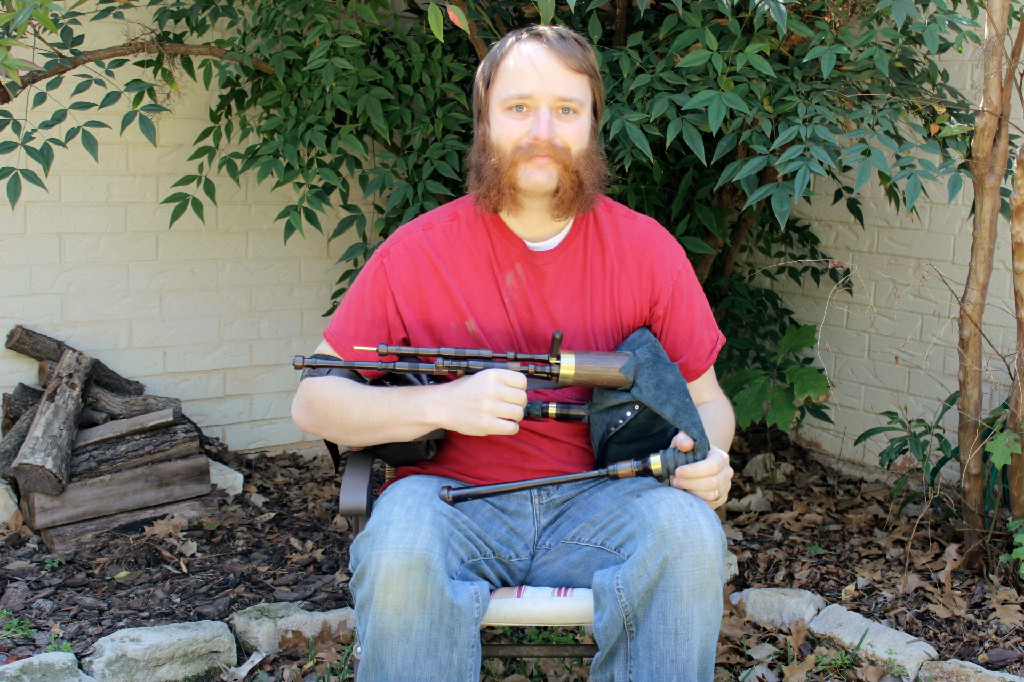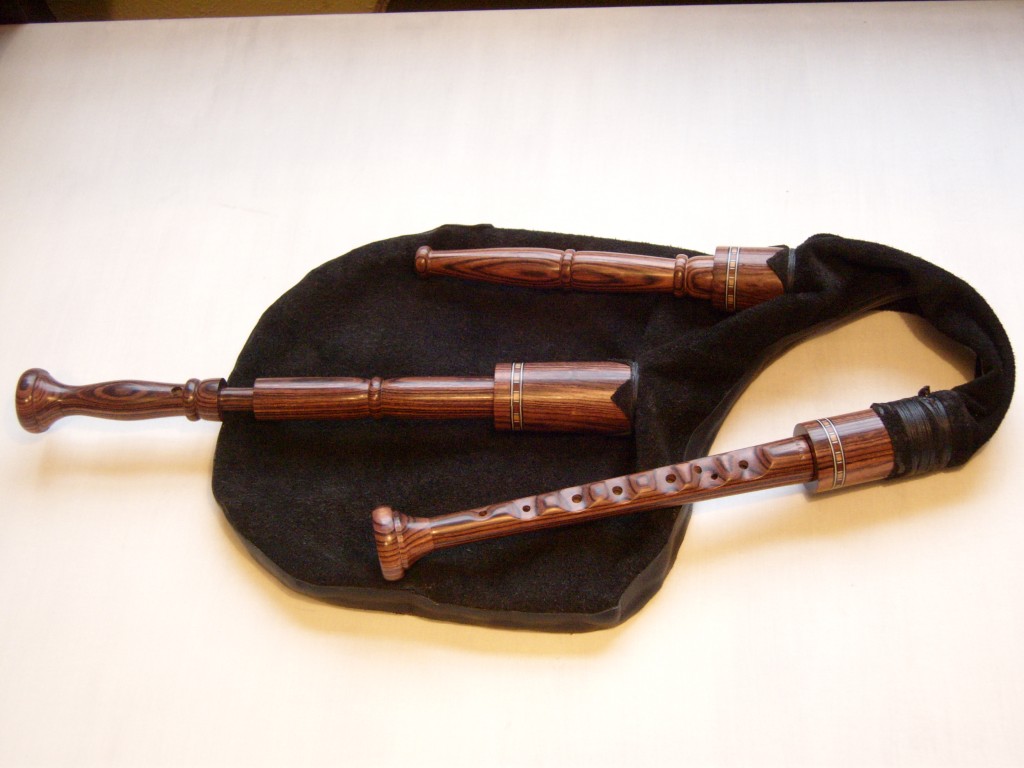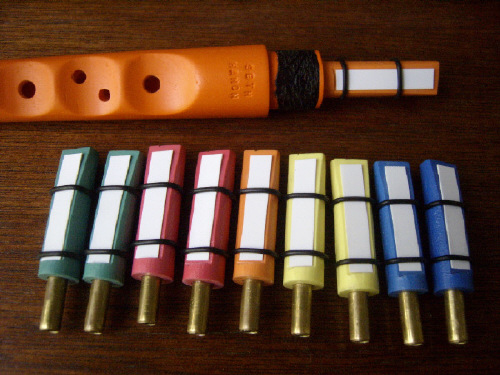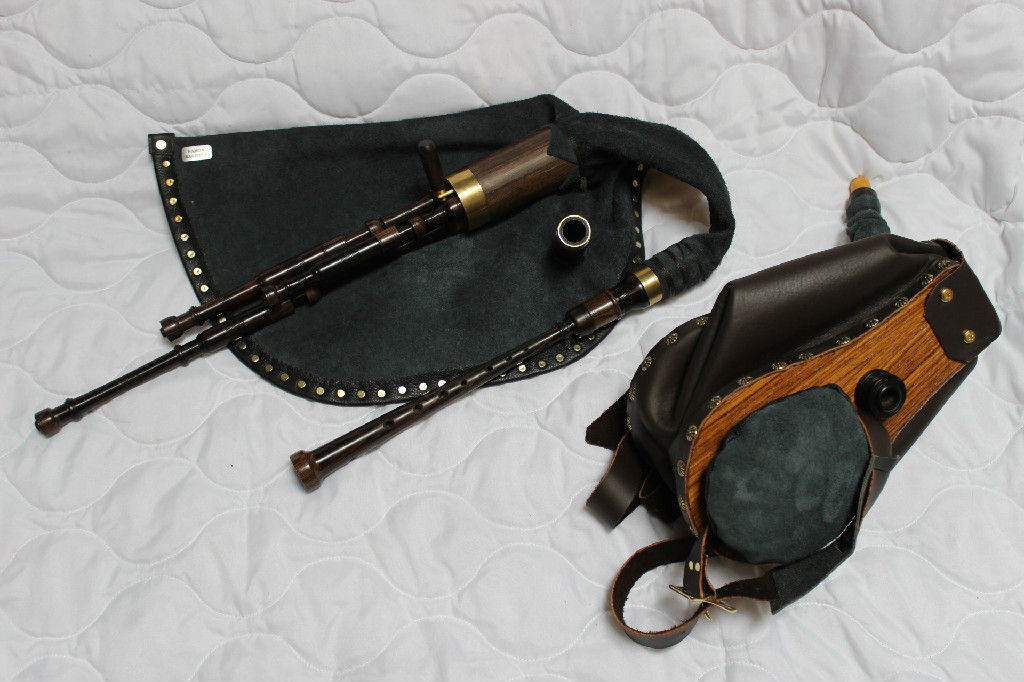by Michael Simone
Editor’s Note – This is one in series of interviews with makers of “alternative” bagpipes. Michael Simone, APNA board member and piper, sent Seth Hamon a series of questions. Seth was kind enough to answer, and at his request we have reproduced his written answers without any editorial alterations.
Although many pipers have known Seth Hamon for quite a while; I wasn’t aware of him until a few years back. Hearing Dick Hensold at one of the pipers’ fora playing the Swedish Sackpipa, I was determined to have one of those chanters! A bit of research and I found Seth. He made a Sackipipa chanter with a tenon to fit my Banton smallpipes. Perfect!
You’ll see, though, that Seth has a repertoire beyond just Sackpipa making. Seth loves making pipes of all types. And bags. And reeds. Do you have an odd requirement? Send him the chanter or drone and he’ll x-ray it and duplicate it for you. We think you’ll like getting to know Seth.
How did your music playing start, what instruments and kinds of music?
I played the trumpet when I was in grade school for a few years but my interest in musical instruments didn’t start until my mid-teens. I bought an electric guitar when I was 16 and played it for a few months and set it down and haven’t played it since. I can remember being interested in the bagpipes from the age of 12 but I didn’t actually start playing until I was 19 which was the summer of 1999.
How long have you been playing the pipes? How did you become interested?
I started playing, as previously stated, when I was 19 years old and I’m 33 now so I’ve been playing almost 14 years. My interest was spurred during visits to the local renaissance festival, Scarborough Faire in Waxahachie Texas. I used to go out there and listen to the Scottish Rogues which was a band that E.J. Jones played in at the time. I quickly found an instructor who actually lives about a mile from where I currently live. I learned to play the Scottish Highland bagpipes from a World Champion, open grade, piper named Robert G. Richardson of Glasgow Scotland, (http://pipemajorrichardson.com/)
Which pipes do you play?
Listed in the order that I learned them Scottish: Highland, Smallpipes, Borderpipes; Irish: Uilleann; Swedish: Säckpipa; Czech/Bohemia: Great Bock; French: Bechonett.
The last two listed I’m still fairly new at.
What is your favorite type of pipe, key, version, etc?
Although I’m really partial to bellow’s blown D smallpipes D,a,d, I would have to say my favorite pipe to play is my 2 drone Swedish Säckpipa in A/e with Smallpipe drones in A-bass / e-baritone
Do you play bellows blown pipes? Why or why not?
I absolutely love playing bellows pipes but I don’t play them as often as I play mouth-blown pipes due to issues related to a hand surgery I had in 2003.
Who has been your biggest influence?
It is really hard to say as I’ve spent years researching old and new instrument makers in all areas, not just bagpipes. More than likely without the literature and published drawings by Leif Eriksson I would not be making bagpipes. My instruments are quite different than his original revival of the Swedish bagpipes but the influence of his work is invaluable to me in my work.
How did you get an interest in the Swedish Bagpipe or Sackpipa?
You know when you first hear an instrument being played and you say to yourself, “I have to have one of those.” That is how it began.
What inspired you to make the leap to crafting your own instrument?
I began to learn to make pipes within months of starting to learn to play. I remember thinking that the construction of a set of pipes looked fairly simple and I got it set in my mind that I was going to make a set, and I did. We won’t talk about the first few sets I made. We will just say that it’s not as simple as I thought. If you stick with it and get your hands on as much information, as well as form friendships with experienced pipe-makers, it will come with time.
How did you start getting into the pipe making profession?
It actually started as a hobby and was for many years until I decided to leave my job as a Network Service tech with a Fortune 500 company to venture off on my own to make pipes full-time
How did you learn your turning skills?
I, as many other pipe-makers, am mostly a self-taught turner, although I did have some formal training when I first started making pipes. I was and still am good friends with a long-time wood worker and turner who managed a Woodcraft store in Fort Worth. I got my start by visiting and turning in the woodworking classroom at the store. Also, my cousin who lived with me at the time worked as an aircraft machinist and he helped me learn to run my metal lathe.
Tell us about your reed making.
Reed-making is a Zen and I really enjoy exploring new designs as well as making existing ones. When it comes to reeds I’m mostly known for my development of the first fully synthetic, plug ‘n play, reed for the Swedish bagpipe which works fairly universal in all makes of Swedish bagpipes. I’ve also developed a single bladed small-pipe drone reed set which is a replacement for a popular mouth-blown U.S. made brand of small-pipes. I’m also working on some new small-pipe drone reed designs. Other than that, I make various cane and plastic reeds for chanters and drones for all the instruments that I build, including Highland practice chanter reeds.
What are you trying to achieve or provide that other makers don’t?
Well, doing anything new in pipe-making is often not new at all. If you think you have achieved something that other makers have not done, you are usually surprised to find that it’s been done. One thing that I can point to that I invented was the first working fully synthetic reed for the Swedish bagpipe. I talked to makers who tried for years to build such a reed and I set out to conquer this task and I succeeded. Now my reeds are used in all makes of Swedish pipes all over the world. My goal is to offer my customers a set of pipes that I would be proud to play myself. I put the same effort and passion into all the pipes that I make and I stand by my work. I strive to keep my prices fair to where I get a decent return on my time and talents and my customers can feel like they got a good deal. The way I can continue to do this is by manufacturing all my own stuff. I’m pretty much at the point where I build everything, with the exception of a few types of reeds.
What do you enjoy doing the most?
I actually enjoy the final turning of the instruments the most. The whole process of cutting the wood, roughing blanks, center drilling, gun-drilling, step boring chanters blanks are all a necessary part of the craft but the Zen of pipe-making for me is the final aesthetic turning of the instrument.
What are the most difficult challenges in your business?
The road to becoming a good and reputable pipe-maker has many rewarding challenges but if I had to pick one out of many I would say reed-making. You can be the greatest pipe-maker in the world but if you make a poor reed then your instruments will suffer. Highland bagpipe makers have it easy in this arena as reeds for Highland pipes are pretty much readily available from a vast choice of different makers. Small-pipe reeds are probably a second in terms of reed availability with more and more reed-makers offering reeds for small-pipes thus making them more readily available at reasonable prices. Learning to make chanter reeds is a must for Uilleann pipe makers as most designs are different and many reeds do not work well in other’s designs. Also, these reeds are incredibly expensive as many Uilleann pipers know. There is not really a readily available source for Uilleann chanter reeds so one must learn to make them on their own. I would venture a guess that if all reed-makers discontinued offering reeds at once that many pipe-makers would be up a creek.
How many sets have you made to date?
One thing I never did is number my sets. I actually started marking my sets with the year back in 2009 which is when I went from part-time to full-time in my pipe-making, but I haven’t kept track of numbers.
What are your preferred materials? Preferred style? Preferred key?
My favorite wood to turn is African Blackwood but I like to use any woods that have a good tone density such as, Mopane, Osage Orange, Lignum Vitae, Pau Ferro, Kingwood, and Olivewood to name a few.
Can you talk about some of the technical challenges in creating your pipes?
Most of the challenges are spent coming up with new designs for pipes, reeds, and tools. Reamers are very challenging and time consuming to make although very rewarding as well, as once you obtain the skill to make your own tools you can replicate and improve upon older instruments.
What is your opinion on the current quality of instruments compared to historical instruments.
Many modern instruments are copies of historical instruments. The differences depend a lot on the makers but in today’s age of pipe-making we have gun drills which produce cleaner and smoother bores than the old makers were able to achieve. I’ve examined many old sets that were clearly made with twist bits or self-made bits and these are pipes made by historically well respected makers. Cane reeds were pretty much exclusively used until the early 80’s and I think that the invention of synthetic drone reeds made pipes easier to keep in tune and maintain resulting in an instrument with a more consistent quality but I have a love/hate relationship with cane so I clearly have a bias. Many historical sets can be reeded with modern reeds and the results are often quite pleasing. I think this is a question that could be debated forever and likely will be.
Are your designs based on vintage or existing instruments? If an instrument is measured and copied do you stay true to the original design, including possible defects, or do you work to improve the design?
I’m really big into measuring old instruments as a part of my continued and constant research in bagpipe design. I always love to get my hands on old instruments when I get the chance. Most of all of the designs that I make are based on vintage instruments that I have measured or from plans that I have obtained over the years. I almost always do not follow exactly a design measured or plans that I receive due to the fact that I often find areas where the design can be improved upon, so often an old set of pipes is only suitable as a good starting point for a new design.
I’m really big into using x-rays along with probing bores during my research of any old bagpipe that I’m interested in recreating or redesigning. I have quite a few x-rays in my office of Border-pipe, Uilleann, Highland, and Reel chanters as well as flute, bombard, and drone x-rays. The x-ray, using a light box, helps you to see what is going on inside the bore as you probe the bore and start to make a profile of what that bore looks like. I think existing instruments are going to be, as they have in the past, a good source for any aspiring pipe-maker wanting to build a quality working set of pipes. In the absence of a good set of plans which are often unavailable to new makers, vintage and existing instruments are often the only way.
Have you had and do you have apprentices, associates, employees?
The only apprentice I’ve ever had was a High School student who came into the shop to learn how to make Highland practice chanters for a Senior project. My father builds restaurant equipment and works in a fab shop and they often work on things for my shop. I do co-own an amateur bagpipe making email list with hundreds of members who I often advise through email. I’ve been doing this for years which I guess could be considered a type of virtual pipe-making help desk or apprenticeship.
What are your thoughts about your business after you can’t or don’t want to continue with it?
I plan on making pipes for the rest of my life or as long as I can physically do the work. I’ll more than likely pass it on to my son Seth, that is if he decides to take an interest in pipe-making.
Who are your favorite musicians to listen to?
Tim Britton, Iain MacHarg, Dråm, E.J. Jones, Pierre Imbert, and too many to list.
Please feel free to add any thoughts, observations, etc.
Anyone who wants to make bagpipes has to be obsessed to a degree, otherwise one would not be able to overcome the frustrations that come with making pipes, especially for the beginning pipe-maker just starting out. I still lie in bed at night thinking of new ways to do things and improve, building things in my mind. I often wake up at night with some of the best ideas to overcome challenges that I’ve been struggling with. For aspiring pipe-makers I’d like to tell them to stick with it and ask questions often and if you come across a problem, take a break and clear your head and think of practical solutions to deal with the situation and then move on.



